mobile View, to the German Version tap the flag
![]()

The Carlists (Carlism) had been since 1833 a monarchist movement in Spain, which went back to Carlos María Isidro de Bourbon. During the Civil War they fought against the left bourgeois republic. In 1937, the political parties National Spain and their militias had been merged, partially with pressure, sometimes even under duress of Franco and some generals to the Phalange Party. These were in addition to the Carlist the national syndicalist Falange, the Alfons-Monarchists, CEDA-Accion Popular, the Nationalist Party and a few others. In principle, the entire range, which was set against the left Republic. This 1937-political-mixture then was also called Falange, but it had no longer much in common with the original, republican, national-syndicalist Falange of Jose Antonio Primo de Rivera, except the flag, which was red-black-red as before, with the badge of the "Catholic Kings" (Isabella and Ferdinand), the yoke and the arrow bundle in red in the middle. Specifically, the forced unification of the party militia was among them in approval (also the proclamation of Franco to Generalissimo – a traditional Spanish title for the supreme commander of the military of Spain, who has temporarily the command for a given military task), because of the "civil war within the Civil War" – Anarchists against the Army of the Republic, Moscow Communists against POUM Trotskyists, etc. – had remained not hidden to the National Spaniards. Gradually disappeared on the Spanish Nationalist Front and in the hinterland, the flags of the dissolved parties. For the militia was only the flag of the Falange allowed (next to the red-gold-red national flag of course). Only in one case, Franco made an exception. The Carlists. For the Navarra brigades, formed of Carlist Requete Militia units of the regular, national Spanish army, it was – in addition to red-gold-red flag – allowed to continue the white flag with the red Burgundian bough cross, also because of their defiance of death. As the Templars they claimed to be "milites christi" - soldiers of Christ. Also for the units of the new united militia, which had its origins in the Carlist requetes, it was allowed to use unofficially the Carlist flag lead with the red Burgundian bough cross on "relevant for them, specific catholic, military and historical holidays and feast days". To the other Falangists this privilege was justifyed, that it is not possible to act against a flag that had served as a regimental flag of the Spanish army in the last 250 years, not least in the War of Independence against Napoleon from 1808 to 1814, and which had also been the flag which had been used for the longest time in the colonial empire of Spain. (Rule of thumb: Burgundy Cross = Army, Red Gold Red = Navy). Source: Jürgen Kaltschmitt, Wikipedia (D) Important flags of the civil war:
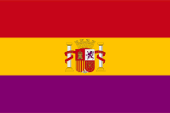
State and naval flag of the left-bourgeois republic,
Source: Flags of the World
![]()
![]()

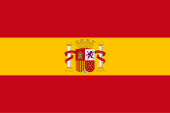
State and naval flag of the national-spanish state,
Source: Flags of the World
![]()
![]()

![]()
Flags of important civil war factions:
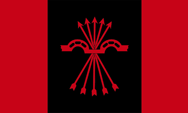
Flag of the Falange-League,
Source: Wikipedia (DE)
![]()
![]()

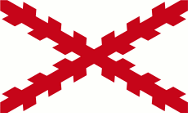
Flag of the Carlist troops,
Source: Wikipedia (DE)
![]()
![]()

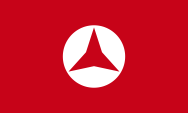
Flag of the People's Front,
Source: Wikipedia (DE)
![]()
![]()

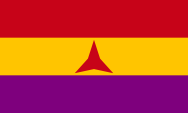
Flag of the International Brigades,
Source: Wikipedia (DE)
![]()
![]()

